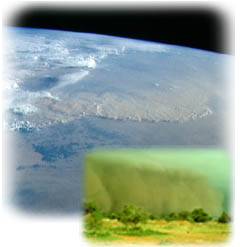|
||||
Measuring Global Environmental Benefits from Local ProjectsIf it can't be measured, will the world care?"Think global, act local" is a rule followed by many environmental agencies to make sure their efforts achieve impact on the ground. But what about impacts in the other direction? If the global community doesn't see benefits from local action, its support may wane, warns the Global Environment Facility (GEF), a United Nations agency that mobilizes international funding to combat environmental degradation. The DMP, ICRISAT and the CGIAR were invited to help brainstorm on this and related issues in a Review Meeting on Sustainable Land Management in Drylands held in Washington, DC during March 5-6th, 2005. The meeting was convened by GEF's Scientific and Technical Advisory Panel (STAP), which advises GEF on funding, science quality, and program matters. GEF's new focus on dryland degradation is particularly relevant to the Desert Margins Program (and to the United Nations Convention to Combat Desertification) since land degradation is a major facet of desertification. The global consequences of land degradation are particularly difficult to measure. The quickest, most visible effects are on the people living on that land, who cannot produce enough food to eat or find water for their livestock. Likewise, local peoples benefit most quickly when land degradation is reversed.
Learn by doingThe group made several suggestions. First, GEF projects presently underway could be asked to 'learn by doing', i.e. to take note of and try to measure the global environmental benefits that they are seeing emerge from their work. Second, the group recommended that GEF prepare a state-of-the-art review of methods for valuing environmental benefits, and guidelines on how this can be applied in reviewing GEF proposals. Third, the group recommended that GEF place emphasis on projects that reduce poverty and improve the livelihoods of land users in dry areas, because those are most likely to deliver benefits that are sustainable. Spreading the benefits of local knowledgeThe meeting also reviewed land-user processes of experimentation and how they can be included in future GEF project design. Those who survive from the land have learned from experience and from their ancestors about how to care for it and sustain it. But with unprecedented growth in populations and competing land pressures, and the influence of government policies, land-users' knowledge must be combined with modern science, policy and governance analysis to achieve desirable outcomes. About the meeting
Drs. Ramadjita Tabo (DMP/ICRISAT-Niamey) and Dr. Bekele Shiferaw (ICRISAT-Nairobi) participated in the consultation. Staff from ICRISAT's sister CGIAR Center ICARDA also attended, contributing ideas from the CGIAR's Integrated Natural Resource Management Task Force. GEF adds 'increments' of assistance to regional, national and local projects so they can generate additional benefits to the global environment. The land degradation focus area adds to its previous four commitments to address the threats of biodiversity loss, climate change, international water degradation, and persistent organic pollutants. Return to On the Edge Newsletter contents page
|
||||
|

 Yet
many indirect effects do spread over time—like
the Sahelian dust storm photographed from space (photo at right)
that sent dirt particles across continents and oceans. Other
examples include the pollution of streams with soil, organic matter
and nutrients that eventually reach the oceans; the release of
carbon into the atmosphere as vegetation is lost; the loss of
globally-useful medicines and other products as dryland species go
extinct; and the out-migration of poor people when their farmlands
become degraded. The problem is that these adverse global
consequences—and the global benefits from combating them—are difficult to
quantify in simple here-and-now terms.
Yet
many indirect effects do spread over time—like
the Sahelian dust storm photographed from space (photo at right)
that sent dirt particles across continents and oceans. Other
examples include the pollution of streams with soil, organic matter
and nutrients that eventually reach the oceans; the release of
carbon into the atmosphere as vegetation is lost; the loss of
globally-useful medicines and other products as dryland species go
extinct; and the out-migration of poor people when their farmlands
become degraded. The problem is that these adverse global
consequences—and the global benefits from combating them—are difficult to
quantify in simple here-and-now terms. GEF and STAP convened the consultation to seek
advice on how best to select projects to address GEF's new (since
2002) focus area on land degradation. The total budget for this
focal area is about US$250 million per year.
GEF and STAP convened the consultation to seek
advice on how best to select projects to address GEF's new (since
2002) focus area on land degradation. The total budget for this
focal area is about US$250 million per year.